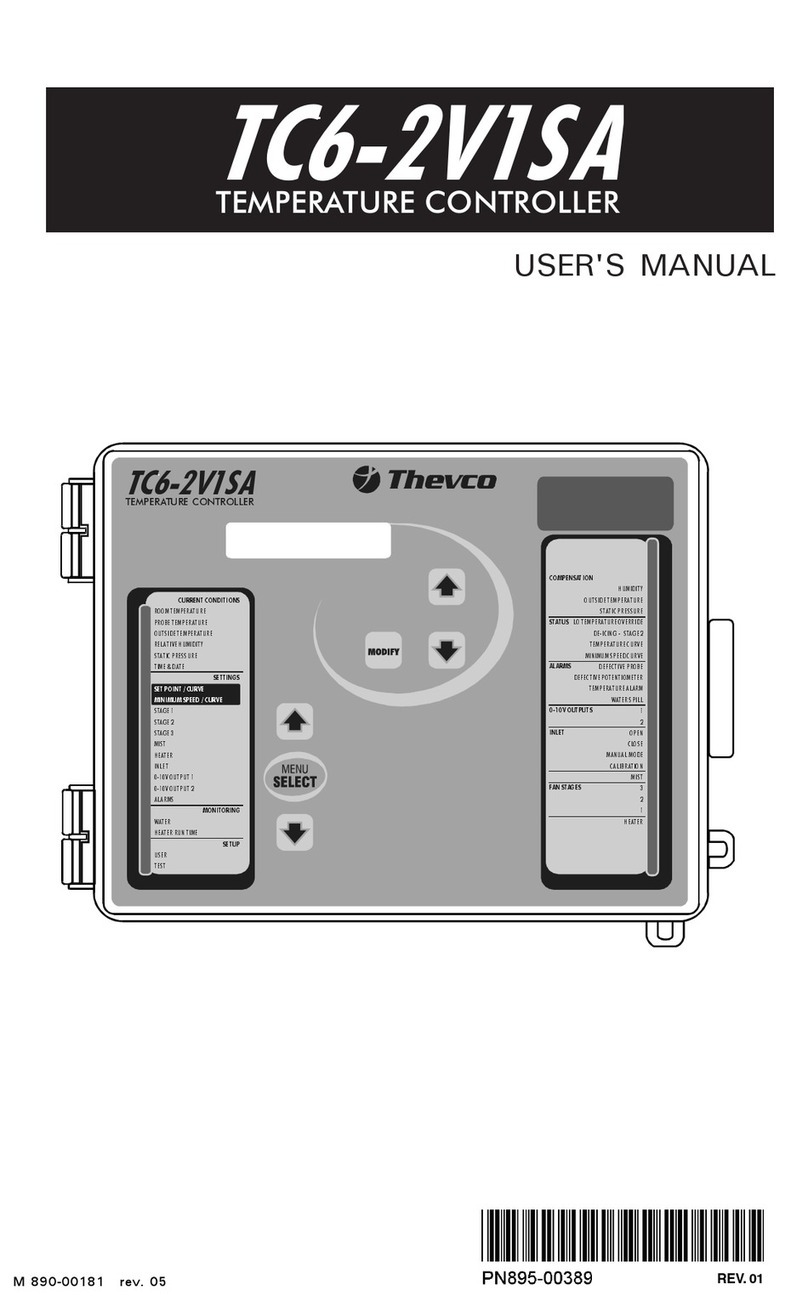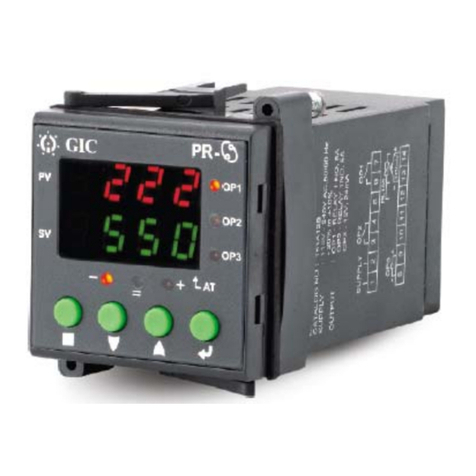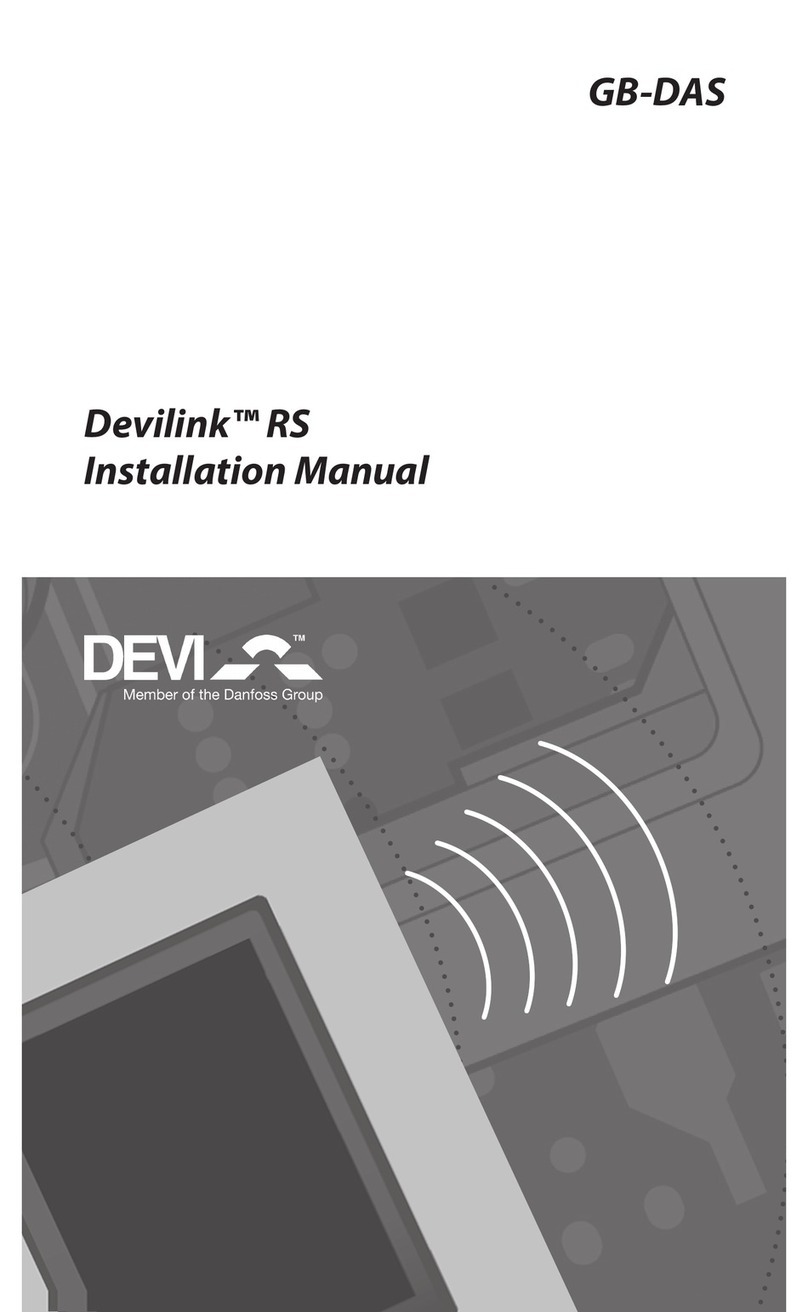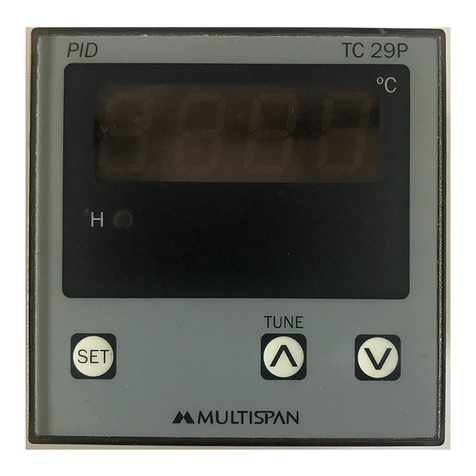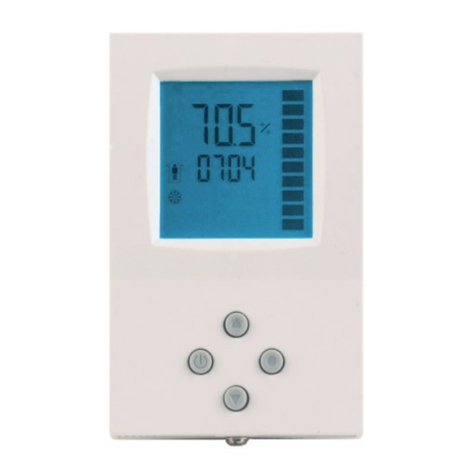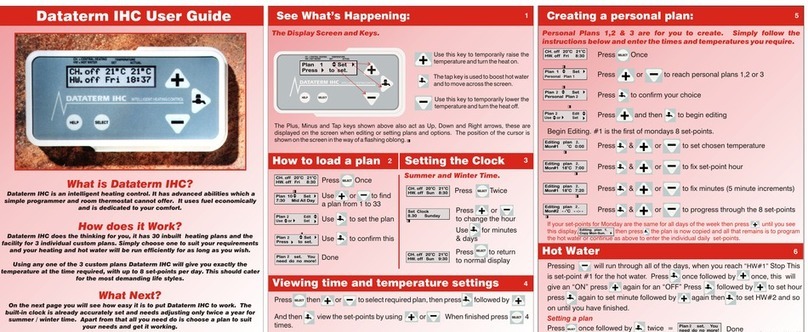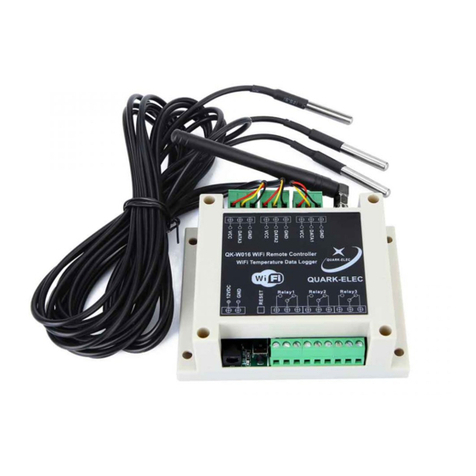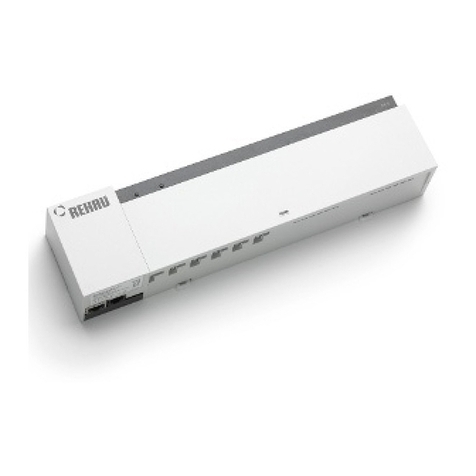Thevco TC5-8SDA User manual

TC5-8SDA
Temperature Controller
USER'S MANUAL
M 890-00177 rev. 03 REV. 01

2TC5-8SDA rev.03
TABLE OF CONTENTS
Page
PRECAUTIONS ....................................................................... 3
FEATURES ............................................................................. 4
LOCATION OF THE CONTROLS ................................................ 6
Controller Status Leds ........................................................... 7
Internal Switches ................................................................. 8
INSTALLATION ...................................................................... 9
Mounting Instructions ............................................................ 9
Connections ........................................................................ 9
Temperature Probes ........................................................... 10
Heating / Cooling Options ..................................................... 12
CHANGING THE PARAMETER SETTINGS ................................. 13
Using the Display ................................................................ 13
Locking the Parameter Settings ............................................ 14
TEMPERATURE SETTINGS ..................................................... 15
Temperature Units .............................................................. 15
Viewing Temperatures ........................................................ 15
Temperature Set Point ........................................................ 18
Temperature Curve............................................................. 19
MINIMUM VENTILATION CYCLE ............................................. 23
Principle of Operation .......................................................... 23
Ramping Option .................................................................. 24
Outside Temperature Compensation ...................................... 26
Minimum Ventilation Settings ............................................... 28
VENTILATION ...................................................................... 30
DEHUMIDIFICATION ............................................................. 34
MIST COOLING .................................................................... 37
HEATER SETTINGS ............................................................... 41
ALARM SETTINGS ................................................................ 46
TEST MODE ......................................................................... 48
TROUBLESHOOTING GUIDE ................................................... 49
TECHNICAL SPECIFICATIONS ................................................ 53
FACTORY SETTINGS............................................................. 54
FUNCTION SUMMARY .......................................................... 55
GLOSSARY ......................................................................... 57

3
TC5-8SDA rev.03
We strongly recommend installing supplementary natural
ventilation as well as a back-up thermostat on at least one
cooling stage (refer to the wiring diagram enclosed with this
user's manual to connect the thermostat).
Although fuses on the outputs of the controller protect its
circuits in case of an overload or overvoltage, we recommend
installing an additional protection device on the controller's
supply circuit.
The room temperature where the controller is located MUST
ALWAYS REMAIN BETWEEN 32°F AND 104°F (0°C TO
40°C).
To avoid exposing the controller to harmful gases or excessive
humidity, it is preferable to install it in a corridor.
DO NOT SPRAY WATER ON THE CONTROLLER
PRECAUTIONS
FOR CUSTOMER USE
Enter the serial number located on
the side of the controller below
for future reference.
Model number:
Serial number:
TC5-8SDA

4TC5-8SDA rev.03
The TC5-8SDA is an electronic device used for environmental control in
livestock buildings. It allows the user to maintain a specified target
temperature by controlling the operation of ventilation and heating
equipment. Six stages of constant-speed fans or mist units and two
stages of either constant-speed fans or heaters can be connected to the
controller. In addition, the last cooling stage can be configured as a mist
stage.
The main features of the TC5-8SDA are as follows:
THREE-DIGIT DISPLAY
A three-digit display provides a high level of accuracy, allowing the user
to specify a temperature to within one tenth of a degree (in Fahrenheit
or Celsius units).
PILOT LIGHTS
Pilot lights indicating the state of outputs allow the user to monitor the
operation of the system without having to enter the building.
MINIMUM VENTILATION CYCLE
When ventilation is not required for cooling, the first stage fans can be
operated either continuously or intermittently to reduce the level of
humidity and supply oxygen to the room.
RAMPING OPTION ON STAGE 1
The running time of the fans can be increased (or decreased) gradually to
smooth out the transition between the minimum cycle and full operation
of Stage 1 fans.
MINIMUM VENTILATION COMPENSATION CURVE
An outside probe can be connected to the controller to adjust the
minimum ventilation cycle as a function of outside temperature.
FEATURES

5
TC5-8SDA rev.03
TC5-8SDA
TEMPERATURE CURVE
The controller can be set to automatically change the temperature set
point over a given period of time in accordance with the user's
requirements by specifying a temperature curve with up to six differ-
ent points.
HUMIDITY COMPENSATION
When the humidity level is high, an additional fan stage can be used to
dehumidify the building. Mist units can also be turned off automati-
cally when the humidity is too high.
HIGH/LOW TEMPERATURE ALARM OUTPUT
FOUR INDEPENDENT TEMPERATURE PROBE INPUTS
Up to four temperature probes can be connected to the controller in
order to obtain a more accurate reading of the average room tempera-
ture and a faster reaction time.
OVERLOAD AND OVERVOLTAGE PROTECTION
Fuses and other protection devices are installed on the outputs of the
controller to protect its circuitry in the case of an overload or over-
voltage.
COMPUTER CONTROL
The controller can be connected to a computer, thus making it pos-
sible to centralize the management of information and diversify
control strategies.
TEST MODE
A test mode allows you to simulate temperature changes and verify
controller performance.

6TC5-8SDA rev.03
LOCATION OF THE CONTROLS

7
TC5-8SDA rev.03
TC5-8SDA
DELGNINAEM
2-1SEGATS EGATSNEHWNOSNRUT.NOERASNAF1EGATSNEHWSEHSALF
.NOOSLAERASNAF2
4-3SEGATS EGATSNEHWNOSNRUT.NOERASNAF3EGATSNEHWSEHSALF
.NOOSLAERASNAF4
6-5SEGATS EGATSNEHWNOSNRUT.NOERASNAF5EGATSNEHWSEHSALF
.NOOSLAERASNAF6
2RETAEH/7EGATS SI2RETAEHNEHWRONOERASNAF7EGATSNEHWNOSNRUT
.NO
1RETAEH/8EGATS SI1RETAEHNEHWRONOERASNAF8EGATSNEHWNOSNRUT
.NO
EVRUCERUTAREPMET .DETAVITCASIEVRUCERUTAREPMETEHTNEHWNOSNRUT
MRALA/EBORP.FED ANEHWSEHSALF.DETCETEDSIMRALANANEHWNOSNRUT
.DETCETEDSIEBORPEVITCEFED
NOITASNEPMOC .TCEFFENISINOITASNEPMOCYTIDIMUHNEHWNOSNRUT
CONTROLLER STATUS LEDS

8TC5-8SDA rev.03
TC5-8SDA
#FFONO
1SRETEMARAPDEKCOLNUSRETEMARAPDEKCOL
2SEERGEDTIEHNERHAFSEERGEDSUISLEC
3DELBASID2EBORPDELBANE2EBORP
4DELBASID3EBORPDELBANE3EBORP
5DELBASID4EBORPDELBANE4EBORP
6DELBASIDEBORPEDISTUODELBANEEBORPEDISTUO
7SEGATSGNITAEHONSEGATSGNITAEH
8RETAEH1SRETAEH2
9SRETAEHGNIDACSACSRETAEHDENOZ
011EDOMTSIM2EDOMTSIM
11FFOTSIMNOTSIM
21DEVRESER
INTERNAL SWITCHES
The internal switches are located on the inside of the front cover.
When the controller is shipped from the factory, all the switches
are set to OFF.
ON
2
13467589 11
10 12

9
TC5-8SDA rev.03
INSTALLATION
MOUNTING INSTRUCTIONS
Open the latch and lift the cover. Remove the black caps located on
each of the four mounting holes. Mount the enclosure on the wall
using four screws. Be sure the electrical knockouts are at the bottom
of the enclosure in order to prevent water from entering the control-
ler. Insert the screws in the mounting holes and tighten. Fasten the
four black caps provided with the controller onto the four mounting
holes. The enclosure must be mounted in a location that will allow the
cover to be completely opened right up against the wall.
CONNECTIONS
To connect the controller, refer to the wiring diagram enclosed with
this user's manual.
Set the voltage switch to the appropriate voltage.
Use the electrical knockouts provided at the bottom of the
enclosure. Do not make additional holes in the enclosure,
particularly on the side of the enclosure when using a computer
communications module.
It may be necessary to install a transformer in order to supply
the appropriate voltage to the heating unit.
ALARM CONNECTION: There are two types of alarms on the mar-
ket. One type activates when current is cut off at its input, whereas
the other activates when current is supplied at its input. For an alarm
of the first type, use the NO terminal as shown on the wiring diagram.
For an alarm of the second type, use the NC terminal.
ALL WIRING MUST BE DONE BY AN AUTHORIZED
ELECTRICIAN AND MUST COMPLY WITH APPLICABLE
CODES, LAWS AND REGULATIONS. BE SURE POWER IS
OFF BEFORE DOING ANY WIRING TO AVOID ELECTRI-
CAL SHOCKS AND EQUIPMENT DAMAGE.
!
WARNING

10 TC5-8SDA rev.03
TC5-8SDA
TEMPERATURE PROBES
1
Connecting the Probes
The controller is supplied with one temperature probe connected to input
# 1. Three additional room probes can be connected to inputs # 2, 3 and
4 and an outside probe can be connected to input # 5 (see wiring
diagram enclosed).
CAUTION: Probes operate at low voltage and are isolated from the
supply. Be sure that probe cables remain insulated from all high voltage
sources. In particular, do not route the probe cables through the same
electrical knockout as other cables. Do not connect the shield from the
probe cable to a terminal or a ground.
Switches are used to activate or deactivate
the additional probes connected to the con-
troller.
Activate each additional probe by setting
the appropriate switch to ON:
• Switch # 3 activates the probe connected to input # 2.
• Switch # 4 activates the probe connected to input # 3.
• Switch # 5 activates the probe connected to input # 4.
2
Extending the Probes
Each probe can be extended up to 500 feet (150 meters). To extend a
probe:
Use a shielded cable of outside diameter between 0.245 and 0.260
in (6.22 and 6.60 mm) (the cable dimensions should not be under
18 AWG) to ensure the cable entry is liquid tight. Do not ground
the shielding.
34
ON
5

11
TC5-8SDA rev.03
TC5-8SDA
It is preferable to solder the cable joint to ensure a proper
contact between the two cables.
CAUTION: Do not run probe cables next to other power cables.
When crossing over other cables, cross at 90°.
3
Installing the Outside Probe
Run the outside probe cable on the north side of the building, 6 ft
(2 m) below the eave, inside a pale colored conduit. Avoid install-
ing the probe in direct sunlight or exposed to the rain.
Be sure the probe cable is isolated from sheet metal or any other
conductive material.
Be sure no cable joint is exposed to air or water.
4
Defective Probes
If a defective probe is detected, the Defective Probe Pilot Light flashes.
The room temperature shown on the display is then the average tempera-
ture measured by the probes in working condition. The controller will
operate according to this temperature.
To identify the defective probe:
Set the selection knob to
ROOM TEMPERATURE . The
room temperature is dis-
played.
Press the push-button. If the
probe connected to input # 1
and supplied with the control-
ler is not defective, the letters"PR1" are displayed, alternating
with the on/off state of the probe and the temperature mea-
sured by the probe. If the probe is defective, the letters "PR1"
are displayed, alternating with the state of the probe and the
letter "P".

12 TC5-8SDA rev.03
TC5-8SDA
For each additional probe connected to the controller:
Press the push-button once again. If the probe is not defective, the
letters "PR#" (where # is the number of the input to which the
probe is connected) are displayed, alternating with the on/off state
of the probe and the temperature measured by the probe. If the
probe is defective, the letters "PR#" are displayed, alternating with
the on/off state of the probe and the letter "P".
Outside Probe: If the outside probe
is defective, the display shows the
letter "P" when the parameter selec-
tion knob is set to OUTSIDE To.
HEATING / COOLING OPTIONS
Stages 7 and 8 can operate as heating or cooling stages.
• Set switches # 7 and # 8 to OFF to use
both stages for cooling.
• Set switch # 7 to ON and switch # 8 to OFF
to use Stage 8 for heating and Stage 7 for
cooling.
• Set switches # 7 and # 8 to ON to use both
stages for heating.
Note that if only one stage is used for heating, it must be Stage 8.
78
ON

13
TC5-8SDA rev.03
CHANGING THE PARAMETER SETTINGS
USING THE DISPLAY
Flashing Values: The display will flash
in certain cases and not in others. The
flashing indicates that the value shown
can be adjusted. A value that is not
flashing cannot be adjusted.
Relative and Absolute Values: Some
parameter adjustments are displayed
both as a relative value and an abso-
lute temperature. This applies to all heating and cooling differentials,
the mist differential and the mist and heater offset. The parameter is
first displayed as a relative value. The corresponding absolute tem-
perature is displayed after six seconds if no action is taken by the
user. The absolute value is the temperature at which the stage turns
on (except in the case of the heater and mist offsets where the value
displayed is the temperature at which the stage turns off). If the user
turns the adjustment knob, the relative value reappears. For example,
when the user turns the selection knob to the differential position
COOLING- DIFF 2-8, the sequence is as follows:
(i) The current differential for stage 2 flashes on the display, alternat-
ing with "St .2".
(ii) If, after about 6 seconds, no action is taken by the user, the
absolute temperature value is displayed, alternating with "St 2" and
"Str". In this case, the absolute value is: Set Point + Stage 1 Differ-
ential + Stage 2 Differential.
78.0
2.0
St 2

14 TC5-8SDA rev.03
TC5-8SDA
LOCKING THE PARAMETER SETTINGS
The parameter settings can be locked to prevent accidentally modify-
ing them. When the settings are locked, only the temperature set
point can be modified (as long as the temperature curve is deacti-
vated).
To lock the parameter settings:
Set internal switch # 1 to ON.
To unlock the parameter settings:
Set internal switch # 1 to OFF.
(iii) When the user turns the adjustment knob to make an adjustment
to the stage 2 differential, the relative value reappears on the display.
In the case of the mist and heating units, the starting temperature is
displayed with the letters "STr" when adjusting the differential and
the stopping temperature is displayed with the letters "STP" when
adjusting the offset.
2.3
78.0 St 2 Str

15
TC5-8SDA rev.03
TEMPERATURE SETTINGS
TEMPERATURE UNITS
Temperatures can be displayed in either Celsius or Fahrenheit units
Set internal switch # 2 to the desired position:
• ON to display temperatures in Celsius units.
• OFF to display temperatures in Fahrenheit units.
VIEWING TEMPERA-
TURES
To display the desired temperature,
set the selection knob to ROOM
TEMPERATURE. The readout can
display values from -40.0oF to
120.0oF ( -40.0oC to 48.9oC).
1
Viewing Room Temperature
The room temperature is the average value of all temperatures
measured by activated probes in proper operating condition.
Set the selection knob to ROOM TEMPERATURE / PROBE To. The
room temperature is displayed.
2
Viewing Probe Temperatures
The controller can display probe temperatures individually. Probes can
also be turned on or off to control the temperature in different parts
of the building.
Set selection knob to ROOM TEMPERATURE / PROBE TEMP. The
average room temperature is displayed.
ON
2

16 TC5-8SDA rev.03
TC5-8SDA
Press the push-button. The temperature reading from probe 1 is
displayed, alternating with the letters "Pr 1" and the on/off state of
probe 1.
For each additional probe, press the push-button. The temperature
reading from probe x is displayed, alternating with the letters "Pr
x" and the on/off state of the probe, etc.
Note: The display returns to the average room temperature after one
minute.
3
Viewing OutsideTemperature
The outside temperature can be
viewed only if a probe is connected
to input # 5.
Set the selection knob to OUT-
SIDE To. The outside tempera-
ture is displayed. If no outside
probe is connected, "----" is dis-
played.
4
Viewing Minimum / Maximum Temperatures
The minimum and maximum temperatures are the lowest and highest
temperature values recorded since the last reset. Maximum and mini-
mum temperatures values are recorded for the average room or outside
temperature as well as for individual probe temperatures.
Set the selection knob to ROOM TEMPERATURE / PROBE TEMP or
OUTSIDE T°. The current room or outside temperature is dis-
played.
Turn the adjustment knob clockwise by one notch. The minimum
temperature flashes on the display, alternating with the letters
"Lo".

17
TC5-8SDA rev.03
TC5-8SDA
Turn the adjustment knob clockwise one notch further. The
maximum temperature flashes on the display, alternating with
the letters "Hi".
Turn the adjustment knob clockwise a third notch. The room
temperature is displayed again.
For each individual probe, press the push-button. The tempera-
ture reading from probe x is displayed, alternating with the
letters "Pr x" and the on/off state of the probe.
Turn the adjustment knob clockwise by one notch. The minimum
temperature is displayed, alternating with the letters "Lo".
Turn the adjustment knob clockwise one notch further. The
maximum temperature is displayed, alternating with the letters
"Hi".
Turn the adjustment knob clockwise a third notch. The probe
temperature is displayed again.
Press the push-button to access the other probes, etc.
NOTE: If you let the display flash for more than 10 seconds, the
controller resets the minimum and maximum temperatures currently in
memory (the display stops flashing to indicate that the reset has been
done).

18 TC5-8SDA rev.03
TC5-8SDA
TEMPERATURE SET POINT
The temperature set point is the target room temperature. It can be
adjusted between -40.0°F and 99.9°F (-40.0°C and 37.7°C).
Adjusting Temperature Set Point
Set the selection knob to SET
POINT / T° CURVE.The
current set point flashes on the
display.
Use the adjustment knob to
adjust the set point to the
desired value.
NOTE: The temperature set point
can be adjusted only if the tempera-
ture curve is deactivated (see
following section).

19
TC5-8SDA rev.03
TC5-8SDA
TEMPERATURE CURVE
The user can define a temperature curve to adjust the set point
automatically over a given time period.
A curve is defined using six points. Each point specifies a day number
and a set point for that day. Once the points of the curve are defined,
the curve must be activated. The controller will change the tempera-
ture set point every hour in a linear fashion between consecutive
points of the curve. When the last point of the curve is reached, the
temperature set point for that day is maintained until the curve is
reactivated.
NOTES :
i) All six points of the curve must be specified. If six points are not
needed, repeat the last temperature value for each unnecessary point.
ii) Certain restrictions apply to reduce the risk of errors:
- The highest possible day number is 99.
- Decreasing day numbers are not allowed.
- Increasing temperatures are not allowed.
- The temperature variation cannot exceed 3°F (1.6°C) per day.
Temperature
Days
To1
To2
To3
To4
To5
To6
d4 d25 d35 d50 d70 d80
○○○○○○○○○○
○○○○○○○○○
○○○○○○○○
○○○○○○
○○○○○
○○○○

20 TC5-8SDA rev.03
TC5-8SDA
1
Specifying the Curve
Set the selection knob to SET
POINT / ToCURVE. The
current temperature set point
flashes on the display.
Press the push-button. The
word OFF is displayed indicat-
ing that the termperature
curve is deactivated. If this is
not the case, see below to deactivate the curve.
Repeat the following steps for each of the six points:
Press the push-button once again. The day number is displayed,
alternating with the word "day".
Using the adjustment knob, set the day number to the desired
value.
Press the push-button once again. The current temperature set
point is displayed, alternating with the word "set".
Using the adjustment knob, adjust the set point to the desired
value.
Once the six points of the curve have been specified, activate the
curve as explained below.
NOTE: Make sure the temperature curve is deactivated before
specifying new points (see below).
Table of contents
Other Thevco Temperature Controllers manuals
Popular Temperature Controllers manuals by other brands
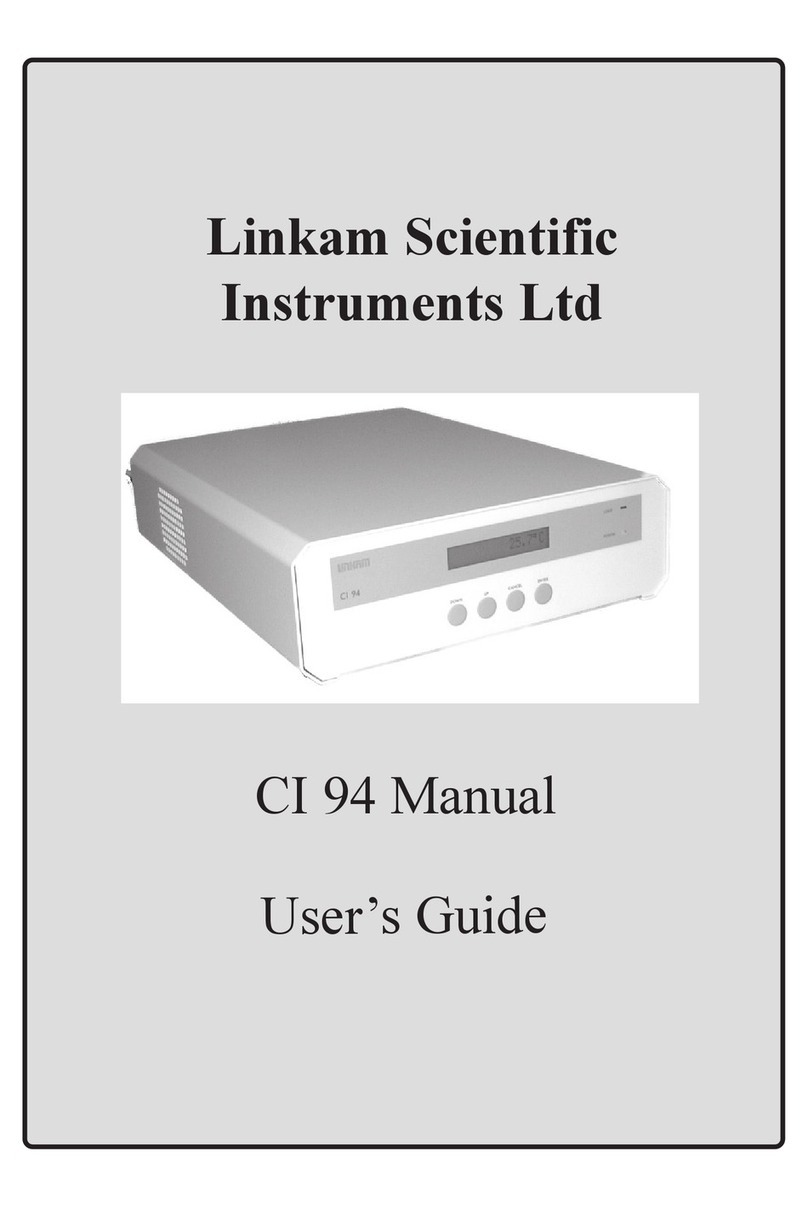
Linkam Scientific Instruments
Linkam Scientific Instruments CI 94 user guide
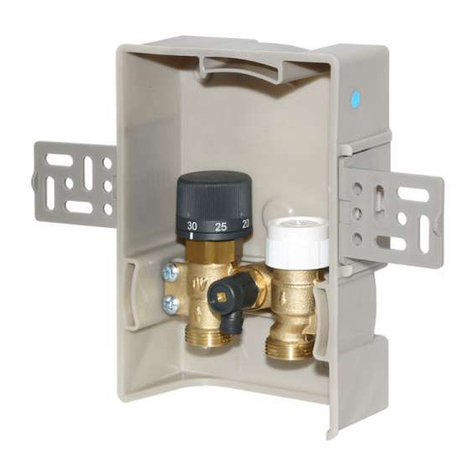
oventrop
oventrop Unibox E BV vario operating instructions

AURATON
AURATON 3021 RT owner's manual
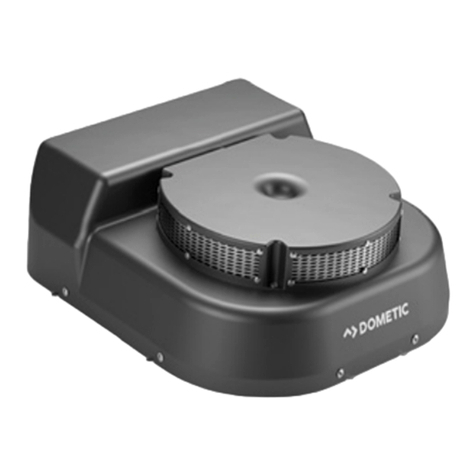
Dometic
Dometic Frigo DC Service manual

Sterling
Sterling Sterltronic S-Series Service and instruction manual
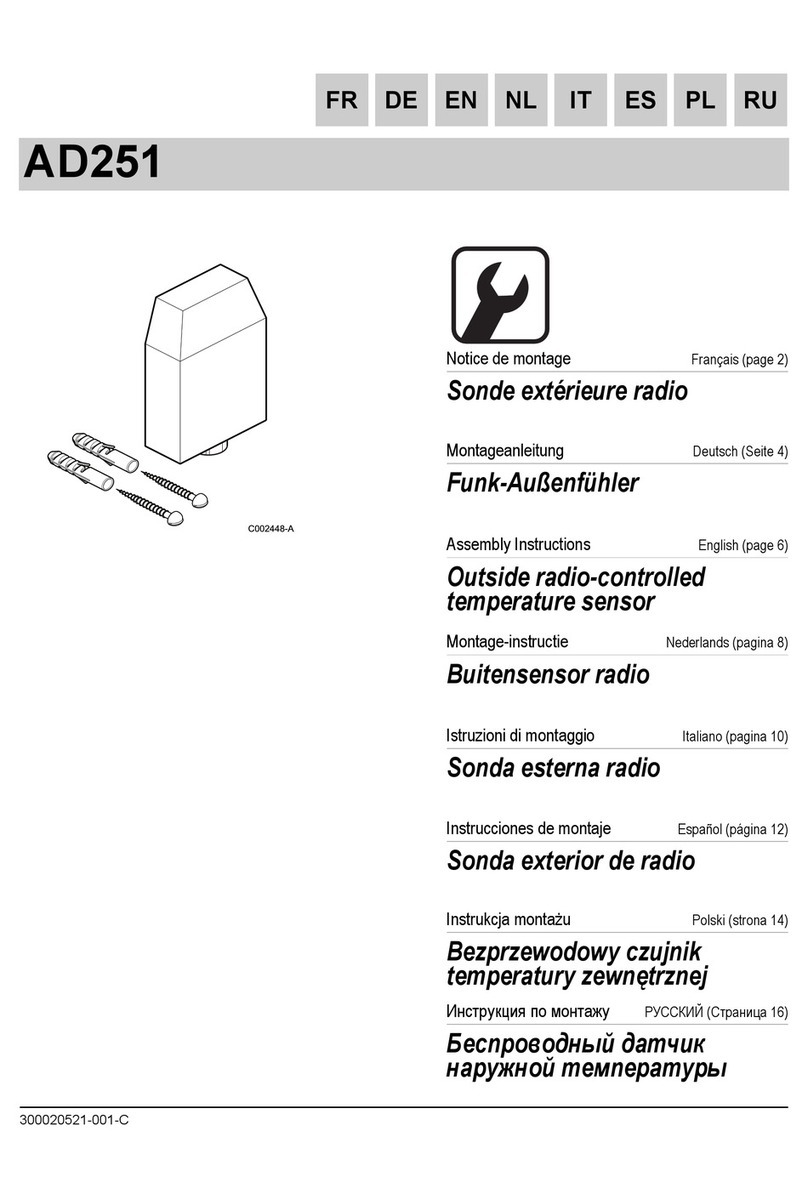
DeDietrich
DeDietrich AD251 Assembly instructions
